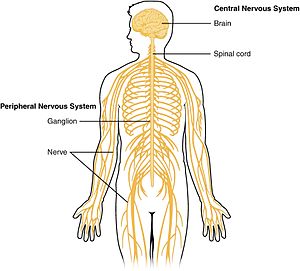Nerves, sensory organs, the brain, and spinal cord all make up this system. There are four different types of nerves in their respective areas; cranial, central, peripheral, and autonomic nerves. The purpose of this system is to take all sensory information, and reacts accordingly. These nerves can cause pain, and make muscles move. The nerves send in pain signals from the brain after sensing. The nervous system also controls some parts of the metabolic process. There are two main parts of this system which include the central and peripheral nervous system. The brain and spinal cord are part of the central nervous system, while nerves are apart of the peripheral nervous system. There are also two main cell types which are neurons, and glial cells. Compared to the endocrine system which is closely related this system targets specific areas for short amounts of time.

action potential: the change in electrical potential associated with the passage of an impulse along the membrane of a muscle cell or nerve cell.
afferent neuron: are pathways that carry sensory information from the body to the central nervous system
Axon: the long threadlike part of a nerve cell along which impulses are conducted from the cell body to other cells.
cell body: the nucleus-containing central part of a neuron exclusive of its axons and dendrites that is the major structural element of the gray matter of the brain and spinal cord, the ganglia, and the retina—called also perikaryon, soma.
Central Nervous System: the complex of nerve tissues that controls the activities of the body. In vertebrates it comprises the brain and spinal cord
Dendrite: a short branched extension of a nerve cell, along which impulses received from other cells at synapses are transmitted to the cell body.
depolarization: loss of the difference in charge between the inside and outside of the plasma membrane of a muscle or nerve cell due to a change in permeability
efferent neuron: conducting cells that carry information from the central nervous system (the brain and spinal cord) to muscles and organs throughout the body.
Ganglia: a structure containing a number of nerve cell bodies, typically linked by synapses, and often forming a swelling on a nerve fiber
Interneuron: a neuron that transmits impulses between other neurons, especially as part of a reflex arc.
motor neuron: a nerve cell forming part of a pathway along which impulses pass from the brain or spinal cord to a muscle or gland.
Na+/ K+ pump: moves these two ions in opposite directions across the plasma membrane.
Nerve: a whitish fiber or bundle of fibers that transmits impulses of sensation to the brain or spinal cord, and impulses from these to the muscles and organs.
nerve impulse: a signal transmitted along a nerve fiber. It consists of a wave of electrical depolarization that reverses the potential difference across the nerve cell membranes.
Neuron: a specialized cell transmitting nerve impulses; a nerve cell.
neurotransmitter: a chemical substance that is released at the end of a nerve fiber by the arrival of a nerve impulse and, by diffusing across the synapse or junction, causes the transfer of the impulse to another nerve fiber, a muscle fiber, or some other structure.
Peripheral Nervous System: the nervous system outside the brain and spinal cord.
polarization: process of producing a positive electrical charge and a negative electrical charge such that between a nerve cell internal electrical charge, which is negative, and the surrounding environment of a nerve cell, which is positive
resting potential: the electrical potential of a neuron or other excitable cell relative to its surroundings when not stimulated or involved in passage of an impulse.
sensory neuron: nerve cells within the nervous system responsible for converting external stimuli from the organism's environment into internal electrical impulses.
stimulus: a thing or event that evokes a specific functional reaction in an organ or tissue.
synapse: a structure that permits a neuron (or nerve cell) to pass an electrical or chemical signal to another neuron.
synaptic cleft: A microscopic gap
threshold potential: critical level to which a membrane potential must be depolarized to initiate an action potential.
http://www.innerbody.com/image/nervov.html
http://www.p-i-a.com/Magazine/Issue3/neuronanim.gif
http://www.p-i-a.com/Magazine/Issue3/neuronanim.gif
https://upload.wikimedia.org/wikipedia/commons/thumb/d/d3/1201_Overview_of_Nervous_System.jpg/300px-1201_Overview_of_Nervous_System.jpg
No comments:
Post a Comment